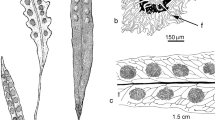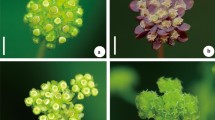Abstract
A known species, Physarum melleum, was found fruiting on living leaves of Dendrobium candidum, which was collected in China in 2004. Its morphological characters were revealed by light microscopy (LM), environmental scanning electron microscopy (ESEM) and scanning electron microscopy (SEM). Character variations were distinguished by its olive-yellow peridium and its always thinner capillitium containing globulose granular material between the large calcareous nodes. The calcium carbonate granules, deposited on stalks, peridium and hypothallus as well as within stalks, were globose and smooth.
Similar content being viewed by others
References
Alexopoulos, C.J., Mims, C.W., Blackwell, M., 1996. Introductory Mycology, 4th Ed. John Wiley and Sons, New York, p.775–808.
Chen, S.L., Li, Y., Li, H.Z., Wang, D.P., 1999. A preliminary report on the myxomycetes from Zhangjiajie, Hunan Province. J. Wuhan Bot. Res., 17(3):217–219 (in Chinese).
Clark, J., Stephenson, S.L., 2003. Biosystematics of the myxomycetes Didymium squamulosum, Physarum compressum, and Physarum melleum: additional isolates. Mycotaxon, 85:85–89.
Couch, H.B., 1995. Diseases of Turfgrass, 3rd Ed. Krieger Publishing Company, Malabar, Florida, p.421.
Filipowicz, A., 1979. Sluzowee (myxomycetes) patogenami truskawek [the slime molds (myxomycetes) as pathogens of strawberries]. Ochr. Rosl., 23:15–16.
Golenia, A., Rebendel, Z., 1970. Masowe wystepowanie sluzowca Diachea leucopodia (Bull.) Rost. na truskawkach [Mass occurrence of slime mold Diachea leucopodia (Bull.) Rost. on the strawberries]. Prace Nauk. IOR, 12:267–271.
Keller, H.W., Braun, K.L., 1999. Myxomycetes of Ohio: their systematics, biology, and use in teaching. Ohio Biol. Surv. Bull. New Ser., 13:182.
Schnittler, M., Stephenson, S., 2002. Inflorescences of neotropical herbs as a newly discovered microhabitat for myxomycetes. Mycologia, 94(1):6–20. [doi:10.2307/3761841]
Sharnoff, S.D., 1991. Beauties from a beast: woodland Jekyll and Hydes. Smithsonian, 22(4):98–103.
Stephenson, S.L., Stempen, H., 1994. Myxomycetes: A Handbook of Slime Molds. Timber Press, Portland, Oregon, p.183.
Townsend, J.H., Aldrich, H.C., Wilson, L.D., McCranie, J.R., 2005. First report of sporangia of a myxomycete (Physarum pusillum) on the body of a living animal, the lizard Corytophanes cristatus. Mycologia, 97(2):346–348.
Zhang, J.Z., Li, J., Xu, T., 2007. First report of Phytophthora nicotianae causing blight of Dendrobium candidum in Zhejiang Province, China. Plant Pathology, in press.
Author information
Authors and Affiliations
Corresponding author
Additional information
Project (No. 2001BA744C) supported by the 10th Five-year National Key Technologies R & D Program, China
Rights and permissions
About this article
Cite this article
Zhang, Jz., Liu, Ln., Fiore-Donno, AM. et al. Ultrastructural characters of a Physarum melleum on living leaves of Dendrobium candidum in China. J. Zhejiang Univ. - Sci. B 8, 896–899 (2007). https://doi.org/10.1631/jzus.2007.B0896
Received:
Accepted:
Issue Date:
DOI: https://doi.org/10.1631/jzus.2007.B0896




